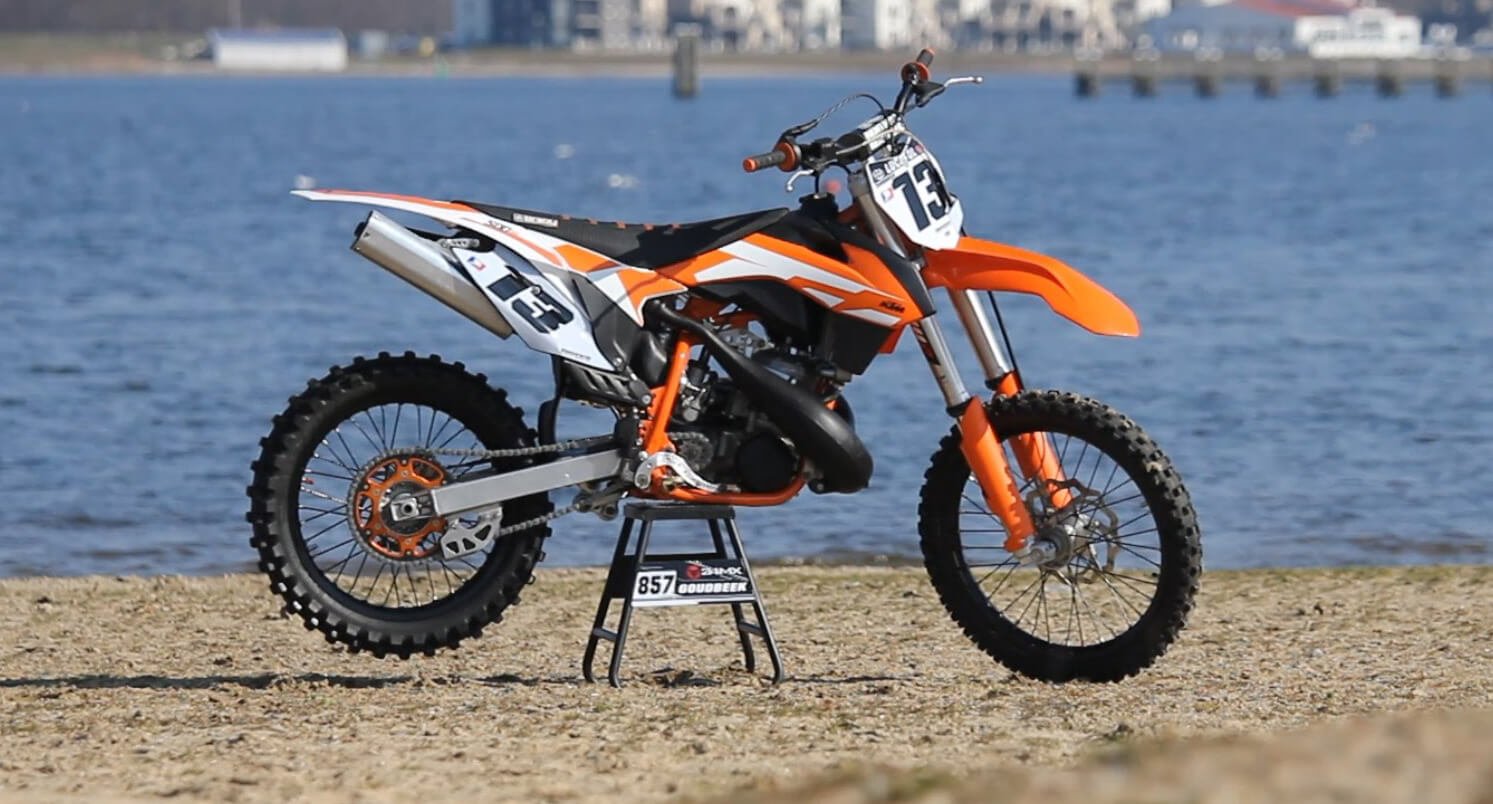Raw power, crazy torque, and easy wheelies are just a few of the many reasons why riding a street legal two-stroke is an experience all its own.
To paint a fuller picture of why you’d want a two-stroke in the first place, let’s explore the history and functionality of the two-stroke dirt bike engine and take a guess at where it’s headed next.
It’s all in an effort to answer one of 2018’s most popular questions: are two-strokes a dying breed? And what makes them the ideal street-legal dirt bike?
A KTM 250 SX two-stroke
Why Are Two-Stroke Engines Amazing?
Let’s start from the top.
There are four stages in the combustion cycle: intake, compression, power, and exhaust.
In a four-stroke engine these steps are achieved as the piston completes two rotations through the cylinder. A precise balance of pressures and vacuums is maintained by using valves to meter airflow, injectors to deliver fuel, and timing chains or belts to keep everything in sync.
The resulting homeostasis allows for a smooth power curve and precise control over emissions, two of the main reasons why most of today’s road-going car and motorcycle engines are four-strokes instead of two.
A basic two-stroke engine doesn’t have most of that stuff, yet it weighs less and makes more power.
A two-stroke has the same four-stage engine cycle, but it does it all in just one rotation of the piston. It uses intake and exhaust ports along the cylinder wall to manage intake and exhaust gases, creating an organic exchange of pressures and vacuums without the use of valves, fuel injection, or even an accelerator pump.
And where a four-stroke might use turbocharging or supercharging to increase power, a two-stroke uses sound.
Yes, sound.
Ever wonder why two-stroke dirt bikes have those big, bulbous exhaust pipes? Check it out in that photo of the KTM from earlier.
That chamber takes the sound waves created by the combustion process and reflects them back toward the engine, briefly forcing the exhaust gases back into the cylinder. At high RPMS this process acts like a supercharger, reaching peak efficiency when the returning sound waves hit the exhaust port during the compression stroke.
People use the phrase “on pipe” to describe a two-stroke’s power band, and coming on-pipe is an abrupt transition that catches many inexperienced riders off-guard because it delivers insane amounts of power in an instant.
So two-stroke engines make more power using fewer parts, they weigh a lot less because of it, and thanks to their simplicity, backyard engine rebuilds are so easy a child can do it. In fact, a two-stroke engine makes nearly 30% more power than an equivalent displacement four-stroke. It’s a win-win for adrenaline junkies and thrill seekers, so why aren’t they all over the place?
If you’d like to see a visualization of two-stroke and four-stroke engines, this video does a great job of it.
Why Two-Stroke Road Bikes Are Gone
You know how we’ve had electric cars for over a hundred years, yet we’re only just now seeing them on the road? It’s kind of like that.
Back in the 1970s, two-stroke road bikes like the original Kawasaki H2 were making all the other bikes look like bicycles. Coincidentally, that was around the time people began to care about words like “smog” and “emissions” in unprecedented ways.
The fact that you could watch the pollutants exiting the tailpipe of a two-stroke vehicle didn’t sit well with the burgeoning environmental movement, and the idea of smoke visibly exiting the exhaust was thought to be directly tied to decades of thick smog in cities like Los Angeles.
While that idea wasn’t entirely wrong, anyone in 2018 will take one look at those pictures and realize there’s no way those little two-stroke engines were responsible for all that smog. The simple fact is that four-stroke emissions were horrid as well; engine technology had to improve, and it had to happen fast.
Check out our take on the 6 Best Factory Street-Legal Dirt Bikes!
The use of valves, cams, and timing systems in four-strokes made it relatively easy to fine-tune them for better emissions. Amid increasingly strict EPA regulations of the 70s and 80s, it was more economically viable for manufacturers to invest in four-stroke engines than to spend years and millions researching how to make a two-stroke engine achieve the same result.
Soon, major brands began choosing four-stroke engines for motorcycles and passenger cars around the world, and by the mid-1990s road-going two-strokes had all but died out.
Despite the higher initial cost of four-stroke motorcycles, the public and their lawmakers (many of whom didn’t ride at all) embraced this technology because in their eyes those noisy smoke-belching two-strokes were the reason they couldn’t see the Hollywood sign on their way to work every morning.
Not that their 8.2-liter Cadillacs or their 5.7-liter Corvettes had anything to do with it – hulking V8s which were so inefficient they made less than 200 horsepower each. But I digress.
Why Two-Stroke Dirt Bikes Are Still Around
Luckily for us dirt bikers, EPA regulations don’t apply to off-road vehicles.
Major brands like Honda and Yamaha continued to embrace two-strokes well into the 90s, and the sport of Motocross did as well. Hardly any four-strokes could compete against the super light and insanely powerful two-strokes in sanctioned racing, and two-strokes were winning championships left and right well into that decade.
That all came to a head in 1998, when the AMA handed down a landmark ruling that four-stroke dirt bikes up to 450cc could compete against 250cc two-strokes to even out the power advantage. In the following years the pros switched over to four-stroke bikes, and since the public tends to buy whatever the pros ride, two-strokes quickly went the way of the dodo.
But one company didn’t get the memo.
Where Two-Strokes Are Going Next
KTM was almost singlehandedly responsible for preserving the good name of two-stroke dirt bikes through the 2000s and 2010s. As great names like Honda started abandoning this technology, KTM doubled down by offering a full range of off-road two strokes for riders of any experience level. These days over half of KTM’s annual sales are two-strokes, and that’s a great sign for the future of this tech.
If you’ve ever talked to an old-timer you’ve probably heard things like, “you might think your bike is fast, but a two-stroke – now that’s fast.” I used to think those guys were out of touch with modern bikes, but it turns out they’re spot-on: two-strokes are a different beast entirely. Throw a leg over a two-stroke dirt bike and you’ll see what I mean, no matter what you ride right now.
That brings us to now, and over the past few years thousands of riders have discovered the same thing. The number of new two-stroke models has increased exponentially since 2016 with names like Gas-Gas and Beta investing big bucks into this segment, and I’m personally thrilled that this incredible technology has found a way to persevere.
In 2018, the two-stroke saviors at KTM/Husqvarna announced transfer port fuel injection, a technology that ditches the carburetor in favor of precise control over air-fuel mixtures and emissions, potentially leading to a new era of street legal two-stroke engines in a future I would love to live in.
But the cold hard truth is, we could have already had this.
Efficient two-strokes would be over 40 years old by now had the industry focused on two-strokes the first time around. The road bikes of today could be totally different – faster, lighter, and easier to maintain. And because two-strokes are currently selling better than they have in years, there’s a lot of incentive for the industry to keep riding the carbureted cash train until it stops making deliveries. Kinda feels like déjà vu, huh?
But instead of doting about how cool things could have been, I prefer to live in the here now.
This is a call to dirt bike manufacturers: bring back the two-stroke and make it better than ever. They present the ultimate blueprint for a street-legal dirt bike.
Whatever the future holds, Dirt Legal will be there making two-stroke dirt bikes street legal for use in all 50 states. Call or click to see how easy the process can be.





















Are you a Nun of Anarchy or a dirt biking legend just waiting to happen? Time to find out.